Justyna P. Zwolak
QDFlow: A Python package for physics simulations of quantum dot devices
Sep 16, 2025Abstract:Recent advances in machine learning (ML) have accelerated progress in calibrating and operating quantum dot (QD) devices. However, most ML approaches rely on access to large, high-quality labeled datasets for training, benchmarking, and validation, with labels capturing key features in the data. Obtaining such datasets experimentally is challenging due to limited data availability and the labor-intensive nature of labeling. QDFlow is an open-source physics simulator for multi-QD arrays that generates realistic synthetic data with ground-truth labels. QDFlow combines a self-consistent Thomas-Fermi solver, a dynamic capacitance model, and flexible noise modules to produce charge stability diagrams and ray-based data closely resembling experiments. With extensive tunable parameters and customizable noise models, QDFlow supports the creation of large, diverse datasets for ML development, benchmarking, and quantum device research.
BATIS: Bootstrapping, Autonomous Testing, and Initialization System for Quantum Dot Devices
Dec 10, 2024
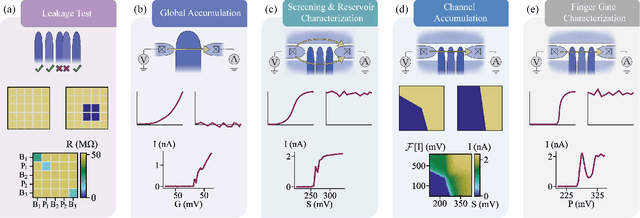
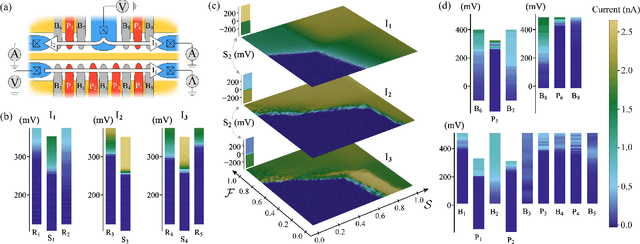
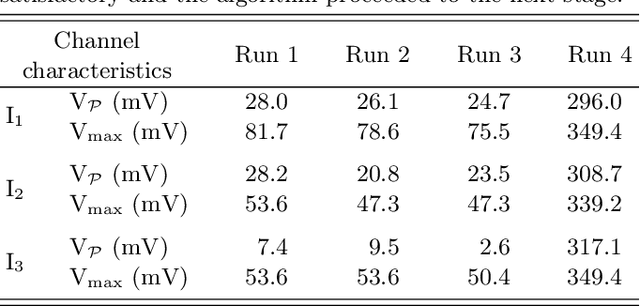
Abstract:Semiconductor quantum dot (QD) devices have become central to advancements in spin-based quantum computing. As the complexity of QD devices grows, manual tuning becomes increasingly infeasible, necessitating robust and scalable autotuning solutions. Tuning large arrays of QD qubits depends on efficient choices of automated protocols. Here, we introduce a bootstrapping, autonomous testing, and initialization system (BATIS), an automated framework designed to streamline QD device testing and initialization. BATIS navigates high-dimensional gate voltage spaces, automating essential steps such as leakage testing and gate characterization. The current channel formation protocol follows a novel and scalable approach that requires a single measurement regardless of the number of channels. Demonstrated at 1.3 K on a quad-QD Si/Si$_x$Ge$_{1-x}$ device, BATIS eliminates the need for deep cryogenic environments during initial device diagnostics, significantly enhancing scalability and reducing setup times. By requiring minimal prior knowledge of the device architecture, BATIS represents a platform-agnostic solution, adaptable to various QD systems, which bridges a critical gap in QD autotuning.
MAViS: Modular Autonomous Virtualization System for Two-Dimensional Semiconductor Quantum Dot Arrays
Nov 19, 2024Abstract:Arrays of gate-defined semiconductor quantum dots are among the leading candidates for building scalable quantum processors. High-fidelity initialization, control, and readout of spin qubit registers require exquisite and targeted control over key Hamiltonian parameters that define the electrostatic environment. However, due to the tight gate pitch, capacitive crosstalk between gates hinders independent tuning of chemical potentials and interdot couplings. While virtual gates offer a practical solution, determining all the required cross-capacitance matrices accurately and efficiently in large quantum dot registers is an open challenge. Here, we establish a Modular Automated Virtualization System (MAViS) -- a general and modular framework for autonomously constructing a complete stack of multi-layer virtual gates in real time. Our method employs machine learning techniques to rapidly extract features from two-dimensional charge stability diagrams. We then utilize computer vision and regression models to self-consistently determine all relative capacitive couplings necessary for virtualizing plunger and barrier gates in both low- and high-tunnel-coupling regimes. Using MAViS, we successfully demonstrate accurate virtualization of a dense two-dimensional array comprising ten quantum dots defined in a high-quality Ge/SiGe heterostructure. Our work offers an elegant and practical solution for the efficient control of large-scale semiconductor quantum dot systems.
Autonomous Bootstrapping of Quantum Dot Devices
Jul 29, 2024Abstract:Semiconductor quantum dots (QD) are a promising platform for multiple different qubit implementations, all of which are voltage-controlled by programmable gate electrodes. However, as the QD arrays grow in size and complexity, tuning procedures that can fully autonomously handle the increasing number of control parameters are becoming essential for enabling scalability. We propose a bootstrapping algorithm for initializing a depletion mode QD device in preparation for subsequent phases of tuning. During bootstrapping, the QD device functionality is validated, all gates are characterized, and the QD charge sensor is made operational. We demonstrate the bootstrapping protocol in conjunction with a coarse tuning module, showing that the combined algorithm can efficiently and reliably take a cooled-down QD device to a desired global state configuration in under 8 minutes with a success rate of 96 %. Importantly, by following heuristic approaches to QD device initialization and combining the efficient ray-based measurement with the rapid radio-frequency reflectometry measurements, the proposed algorithm establishes a reference in terms of performance, reliability, and efficiency against which alternative algorithms can be benchmarked.
Explainable Classification Techniques for Quantum Dot Device Measurements
Feb 23, 2024



Abstract:In the physical sciences, there is an increased need for robust feature representations of image data: image acquisition, in the generalized sense of two-dimensional data, is now widespread across a large number of fields, including quantum information science, which we consider here. While traditional image features are widely utilized in such cases, their use is rapidly being supplanted by Neural Network-based techniques that often sacrifice explainability in exchange for high accuracy. To ameliorate this trade-off, we propose a synthetic data-based technique that results in explainable features. We show, using Explainable Boosting Machines (EBMs), that this method offers superior explainability without sacrificing accuracy. Specifically, we show that there is a meaningful benefit to this technique in the context of quantum dot tuning, where human intervention is necessary at the current stage of development.
* 5 pages, 3 figures
Data Needs and Challenges of Quantum Dot Devices Automation: Workshop Report
Dec 21, 2023Abstract:Gate-defined quantum dots are a promising candidate system to realize scalable, coupled qubit systems and serve as a fundamental building block for quantum computers. However, present-day quantum dot devices suffer from imperfections that must be accounted for, which hinders the characterization, tuning, and operation process. Moreover, with an increasing number of quantum dot qubits, the relevant parameter space grows sufficiently to make heuristic control infeasible. Thus, it is imperative that reliable and scalable autonomous tuning approaches are developed. In this report, we outline current challenges in automating quantum dot device tuning and operation with a particular focus on datasets, benchmarking, and standardization. We also present ideas put forward by the quantum dot community on how to overcome them.
QDA$^2$: A principled approach to automatically annotating charge stability diagrams
Dec 18, 2023Abstract:Gate-defined semiconductor quantum dot (QD) arrays are a promising platform for quantum computing. However, presently, the large configuration spaces and inherent noise make tuning of QD devices a nontrivial task and with the increasing number of QD qubits, the human-driven experimental control becomes unfeasible. Recently, researchers working with QD systems have begun putting considerable effort into automating device control, with a particular focus on machine-learning-driven methods. Yet, the reported performance statistics vary substantially in both the meaning and the type of devices used for testing. While systematic benchmarking of the proposed tuning methods is necessary for developing reliable and scalable tuning approaches, the lack of openly available standardized datasets of experimental data makes such testing impossible. The QD auto-annotator -- a classical algorithm for automatic interpretation and labeling of experimentally acquired data -- is a critical step toward rectifying this. QD auto-annotator leverages the principles of geometry to produce state labels for experimental double-QD charge stability diagrams and is a first step towards building a large public repository of labeled QD data.
Extending Explainable Boosting Machines to Scientific Image Data
May 25, 2023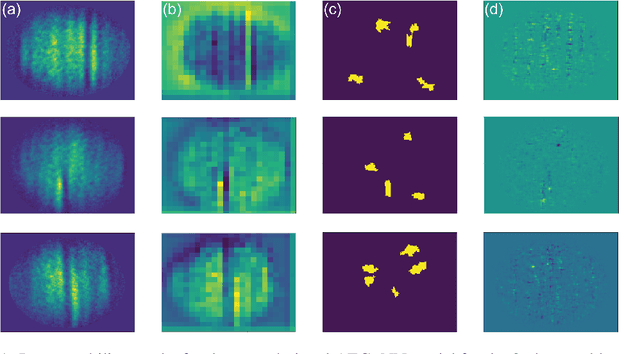
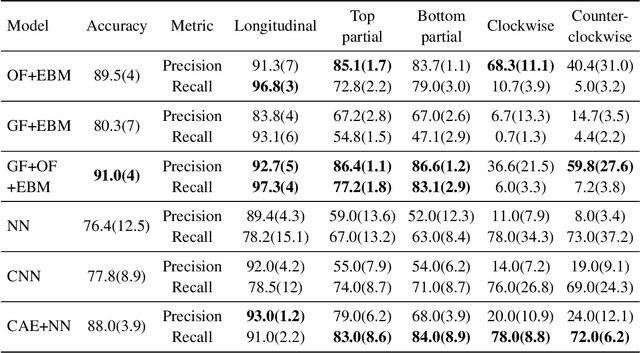
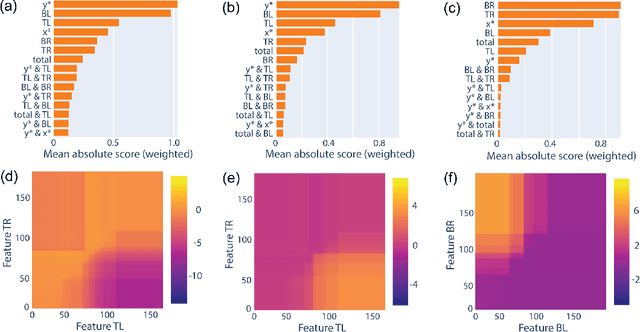

Abstract:As the deployment of computer vision technology becomes increasingly common in applications of consequence such as medicine or science, the need for explanations of the system output has become a focus of great concern. Unfortunately, many state-of-the-art computer vision models are opaque, making their use challenging from an explanation standpoint, and current approaches to explaining these opaque models have stark limitations and have been the subject of serious criticism. In contrast, Explainable Boosting Machines (EBMs) are a class of models that are easy to interpret and achieve performance on par with the very best-performing models, however, to date EBMs have been limited solely to tabular data. Driven by the pressing need for interpretable models in science, we propose the use of EBMs for scientific image data. Inspired by an important application underpinning the development of quantum technologies, we apply EBMs to cold-atom soliton image data, and, in doing so, demonstrate EBMs for image data for the first time. To tabularize the image data we employ Gabor Wavelet Transform-based techniques that preserve the spatial structure of the data. We show that our approach provides better explanations than other state-of-the-art explainability methods for images.
Automated extraction of capacitive coupling for quantum dot systems
Jan 20, 2023Abstract:Gate-defined quantum dots (QDs) have appealing attributes as a quantum computing platform, however, near-term devices possess a range of possible imperfections that need to be accounted for during the tuning and operation of QD devices. One such problem is the capacitive cross-talk between the metallic gates that define and control QD qubits. A way to compensate for the capacitive cross-talk and enable targeted control of specific QDs independent of coupling is by the use of virtual gates. Here, we demonstrate a reliable automated capacitive coupling identification method that combines machine learning with traditional fitting to take advantage of the desirable properties of each. We also show how the cross-capacitance measurement may be used for the identification of spurious QDs sometimes formed during tuning experimental devices. Our systems can autonomously flag devices with spurious dots near the operating regime which is crucial information for reliable tuning to a regime suitable for qubit operations.
Tuning arrays with rays: Physics-informed tuning of quantum dot charge states
Sep 08, 2022



Abstract:Quantum computers based on gate-defined quantum dots (QDs) are expected to scale. However, as the number of qubits increases, the burden of manually calibrating these systems becomes unreasonable and autonomous tuning must be used. There have been a range of recent demonstrations of automated tuning of various QD parameters such as coarse gate ranges, global state topology (e.g. single QD, double QD), charge, and tunnel coupling with a variety of methods. Here, we demonstrate an intuitive, reliable, and data-efficient set of tools for automated global state and charge tuning in a framework deemed physics-informed tuning (PIT). The first module of PIT is an action-based algorithm that combines a machine learning (ML) classifier with physics knowledge to navigate to a target global state. The second module uses a series of one-dimensional measurements to tune to a target charge state by first emptying the QDs of charge, followed by calibrating capacitive couplings, and navigating to the target charge state. The success rate for the action-based tuning consistently surpasses $95~\%$ on both simulated and experimental data suitable for off-line testing. The success rate for charge setting is comparable when testing with simulated data, at $95.5(5.4)~\%$, and only slightly worse for off-line experimental tests, with an average of $89.7(17.4)~\%$ (median $97.5~\%$). It's noteworthy that the high performance is demonstrated both on data from samples fabricated in an academic cleanroom as well as on an industrial 300 mm process line, further underlining the device-agnosticity of PIT. Together, these tests on a range of simulated and experimental devices demonstrate the effectiveness and robustness of PIT.
 Add to Chrome
Add to Chrome Add to Firefox
Add to Firefox Add to Edge
Add to Edge